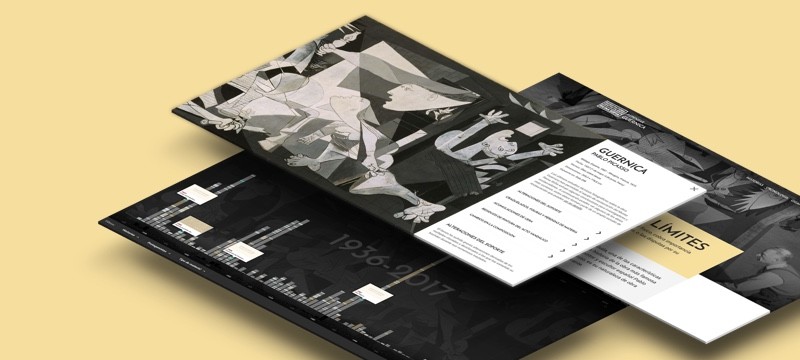En 2011 comenzó el proyecto de investigación que presentamos aquí con el objetivo de profundizar en el estudio de Guernica con nuevos exámenes técnicos realizados con la tecnología más avanzada así como una localización exhaustiva de documentación sobre la obra.
Dada la complejidad que implicaba un proyecto de estas características, se programaron dos fases de actuación. La primera tenía que permitir fotografiar y realizar todos los estudios técnicos con absoluta precisión y cumpliendo la premisa de mantener la obra en su lugar habitual. Para ello se diseñó y desarrolló un sofisticado sistema robotizado que permitió realizar todos los estudios técnicos sin que el horario de apertura al público se viera alterado. La segunda fase se ha centrado en el desarrollo de la tecnología necesaria para procesar la enorme cantidad de imágenes tomadas llamadas macrofotografías que alcanzan un nivel de detalle muy superior al que la vista natural puede apreciar.
First Phase
From 2011 to 2012, the first phase, an automated robot was installed in front of the painting to systematically scan its surface and to capture thousands of macro photographs using multiple spectrum techniques — in some studies, up to 20,592 images were taken with visible light, ultraviolet light and infrared reflectography. The other studies included a high-resolution 3D can and the capture of hyperspectral images. Finally, a scan to analyse the spectral reflectance was also deemed necessary in order to compile precise information on the colour of the painting at the present time.
Robotic automation constituted one of the most complex aspects of the project. Precision and safeguarding the painting were paramount, and advanced technology enabled the robot, via three Cartesian axes, to move with a precision of 25 microns, with different cameras, sensors and lighting systems specific to each technique also capturing highly detailed images as they moved over the surface of the work.
The result of the studies systematically offers both the science community and interested viewers in-depth knowledge of the materials and techniques Picasso used in this vital piece of twentieth-century art.
Second Phase
The second phase, implemented between 2015 and 2017, focused on the interpretation of the technical studies obtained with images previously taken via robotic automation, and involved the need for specific software to be designed and developed which enabled the restoration team to simultaneously view and manage the different studies. In tandem, a databank was created with information obtained by the restoration team after analysing the images with the mapping of alterations. This data was a key tool for studying the work’s state of preservation since it enabled each alteration to be located quickly and technical aspects to be examined.
Despite the complexity involved in the size and brittleness of Guernica, this project afforded experts the chance to work simultaneously with technical studies (visible light, or VIS; ultraviolet light, or UV; infrared reflectography, or IR; and x-rays, or XR) and to broaden details on the work. High-resolution images can reach a much greater magnification than the human eye is capable of and therefore yield comprehensive data on every aspect of deterioration and alterations on the canvas.
For instance, the visible light (VIS) study has enabled us to comprehensively assess and record all aspects related to the alterations to the work which have stemmed from changes at different times, as well as understanding the artist’s rapid and vigorous technique.
In approaching the work through an analysis of the conservation state, one of the most frequent alterations found is the presence of wax, a result of the restoration treatment using wax and resin that was carried out in 1957 at the Museum of Modern Art (MoMA) in New York, and often easily detected with high magnification images.
Furthermore, the results obtained with ultraviolet (UV) light enable us the gain an idea of the scope of this treatment, while the UV fluorescence shows up the colour retouching covering the paint losses.
was composed by Picasso in under two months, and was modified in successive phases as he worked on the pictorial surface. These stages were documented by the photographs taken by the artist Dora Maar and for many years the knowledge related to these changes was based on this documentation. However, for some time now the science community has also frequently turned to the infrared reflectography (IR) technique, studying the changes made to the pictorial surface and revealing the layers that lie in between the support and the polychrome, as well as shedding light on the compositional changes or rectifications Picasso made to the canvas. For instance, this technique enables us to discern how the horse’s head was in a different position, or how, in the early stages of the work, Picasso considered including the figure of a woman on the bottom right of the canvas.
In the results taken from x-ray imaging (XR), we can see the structural elements in the work. Guernica’s current stretcher is not the original; the fragile conservation state of the original prompted the decision at MoMA in 1964 to replace it with the stretcher found today.
This is just some of the data which forms the complete restoration study of Picasso’s Guernica, and which ultimately sets out to compile detailed and precise knowledge of the painting’s state of conservation to guarantee the proper development of one of the twentieth century’s most important works.
This text presents the complete report available for download here.
